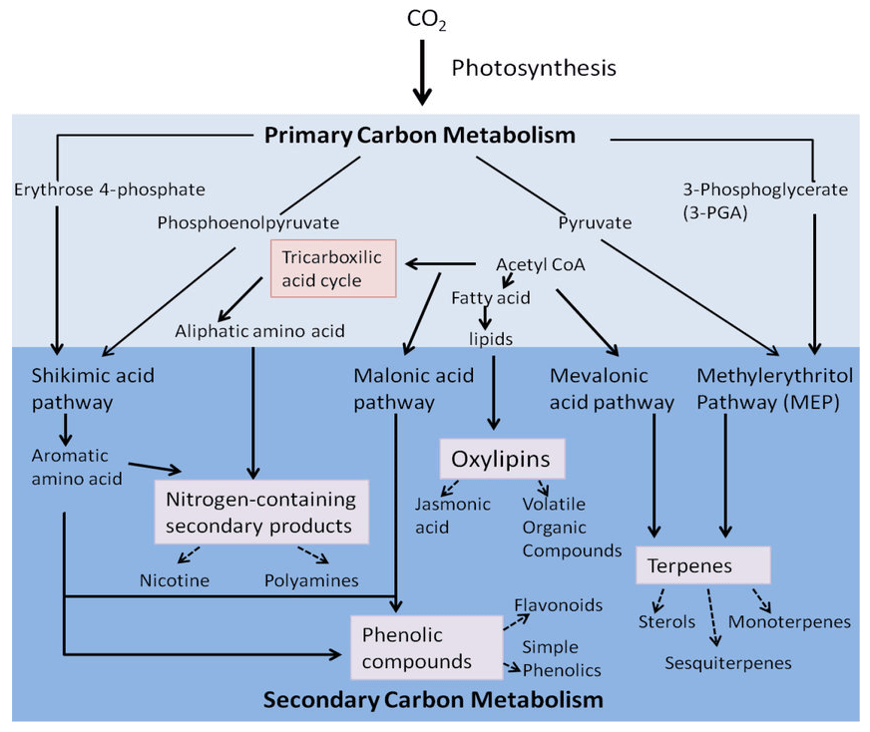Salicylic Acid (SA) Analysis Service
Submit Your InquiryWhat is Salicylic Acid?
Plants have developed complex mechanisms to protect themselves from pathogen attacks and other environmental stresses. In recent years, salicylic acid (SA; 2-hydroxybenzoic acid) has emerged as an important plant hormone with key roles in the defense against biotrophic pathogens. Studies have identified SA receptor proteins and revealed the regulation of pathogen-induced SA biosynthesis and how SA regulates defense gene expression. SA is required for the expression of many defense genes and the assembly of root microbiome. Methyl salicylate (MeSA), a derivative of SA, acts as a long-distance mobile signal for inducing systemic acquired resistance (SAR) in uninfected parts of plants. SA is methylated by SA carboxyl methyltransferase (SAMT) to form MESA, which travels to the systemic tissues and activates resistance following its conversion back SA by SA-binding protein 2 (SABP2). Liquid chromatography-tandem mass spectrometry (LC-MS/MS) is generally used for the detection of SA. Creative Proteomics has developed an accurate and feasible protocol for the quantitative determination of salicylic acid in given plant tissues. Multiple reaction monitoring (MRM) is utilized for data acquisition, which is a highly specific and sensitive label-free technique for detecting and quantifying selected protein/peptides of interest.
 Figure 1. SA undergoes many modifications in plants (Dempsey & Klessig 2017).
Figure 1. SA undergoes many modifications in plants (Dempsey & Klessig 2017).
Why Choose Quantitative Analysis?
Dynamic Concentrations: Salicylic acid levels fluctuate under different conditions. Our quantitative analysis captures these nuances, providing a dynamic understanding of its role in plant physiology.
Comparative Studies: Precise quantification allows for meaningful comparisons between plant species, genotypes, and environmental conditions, facilitating insightful research conclusions.
Diagnostic Precision: In studying plant-pathogen interactions, accurate salicylic acid quantification serves as a diagnostic tool, enabling researchers to assess the efficacy of defense mechanisms.
Optimizing Agriculture: Tailoring agricultural practices requires a deep understanding of salicylic acid dynamics. Our quantification service supports the optimization of crop management strategies for enhanced yield and quality.
Applications of Salicylic Acid Analysis
Plant Physiology Insights: Precise quantification of salicylic acid unravels its role in regulating fundamental aspects of plant physiology, including growth, development, and responses to biotic and abiotic stimuli.
Disease Resistance Evaluation: Our analysis serves as a diagnostic tool for researchers studying plant-pathogen interactions. Accurate quantification enables the assessment of the effectiveness of plant defense mechanisms, contributing to advancements in disease resistance studies.
Environmental Stress Response Understanding: Salicylic acid production in response to environmental stressors is a key focus of our analysis. Explore how plants leverage salicylic acid to cope with challenges such as drought, extreme temperatures, and pollution.
Optimizing Agricultural Practices: Quantification of salicylic acid is instrumental in tailoring agricultural practices. Researchers can harness the protective effects of salicylic acid to optimize crop management strategies, enhancing both yield and quality.
Service Workflow of Salicylic Acid Analysis
Our newly developed sample preprocessing method provides safety, environmental protection, rapidness, effectiveness, and recovery rates consistently exceeding 85%. Sample preprocessing at Creative Proteomics complies with in-house standard operation procedures (SOPs), ensuring maximized homogeneity between samples. Electrospray ionization (ESI) is performed with a triple quadrupole LC/MS system, and MRM is utilized for data acquisition.

Quantification methods: external reference method or isotope-labeled internal standard method
Mode: MRM, capable of simultaneously detecting more than 1000 MRM ion pairs
Precision: ≤10-9 g
Positive/Negative polarity switching time: ≤20 ms, allowing for the acquisition of Q1/Q3 MRM transition mass spectra in both ionization modes from a single LC-MS/MS run.
Salicylic Acid Quantitative Analysis in Creative Protoemics
Quantitative Analysis: Accurate determination of salicylic acid levels in various samples using advanced analytical techniques.
Qualitative Analysis: Identification and confirmation of salicylic acid presence in complex sample matrices.
Metabolite Profiling: Profiling of salicylic acid and its related metabolites to gain insights into metabolic pathways.
Stability Studies: Assessment of the stability of salicylic acid under different storage conditions.
Formulation Analysis: Analysis of salicylic acid content in formulations and products.
Bioavailability Studies: Investigation of the bioavailability of salicylic acid in different formulations.
Matrix Effect Evaluation: Assessment of matrix effects on salicylic acid analysis.
Sample Requirements of Salicylic Acid Analysis
| Sample Type | Sample Volume | Storage Conditions | Special Handling |
|---|---|---|---|
| Serum/Plasma | 100 μL - 500 μL | Store at -80°C | Avoid repeated freeze-thaw cycles. |
| Urine | 1 mL - 5 mL | Store at -80°C | Acidification may be required for stability. |
| Tissue (e.g., Plant Extracts) | 50 mg - 200 mg | Flash freeze with liquid nitrogen and store at -80°C | Homogenization in a suitable buffer. |
| Cell Culture Supernatant | 0.5 mL - 1 mL | Store at -80°C | Centrifugation may be required. |
| Food Samples (e.g., fruits) | 10 g - 50 g | Freeze at -20°C or lower | Homogenization in a suitable solvent or buffer. |
Deliverables
- Experimental procedure
- Parameters of liquid chromatography and MS
- MS raw data files and MS data quality checks
- SA and MESA quantification data
- Custom analysis report
Creative Proteomics provides plant hormones analysis services to determine the level of specific hormones in plant tissues powered by state-of-the-art mass spectrometry coupled with gas chromatography (GC) or liquid chromatography (LC), which is essential for revealing the roles and functions of various phytohormones in plant growth, development, and resistance.
References
- Li Y, Zhang W, Dong H, et al. Salicylic acid in Populus tomentosa is a remote signalling molecule induced by Botryosphaeria dothidea infection. Scientific reports, 2018, 8(1): 1-9.
- Zhang Y, Li X. Salicylic acid: biosynthesis, perception, and contributions to plant immunity. Current opinion in plant biology, 2019, 50: 29-36.
- Dempsey D M A, Klessig D F. How does the multifaceted plant hormone salicylic acid combat disease in plants and are similar mechanisms utilized in humans?. BMC biology, 2017, 15(1): 1-11.
- Zheng W, Yoo K H, Abd El-Aty A M, et al. Quantitative determination of carbasalate calcium derived metabolites, acetylsalicylic acid and salicylic acid, in six animal foods using liquid-liquid extraction method coupled with liquid chromatography-tandem mass spectrometry. Food chemistry, 2019, 278: 744-750.












